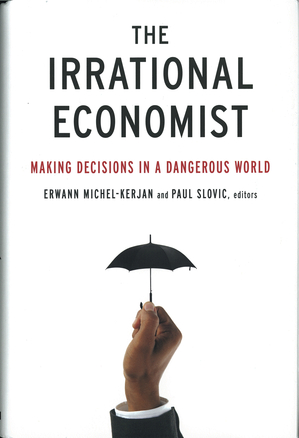 Before the financial meltdown and the subprime mortgage fiasco, the field of economics was enjoying an unparalleled time of mass consensus, according to Paul Krugman, the New York Times columnist and Nobel Prize-winning economist. Seduced by their elegant math, most economists believed that market forces had been tamed, and those who had doubts still believed any hiccups could be corrected by the Federal Reserve.
Before the financial meltdown and the subprime mortgage fiasco, the field of economics was enjoying an unparalleled time of mass consensus, according to Paul Krugman, the New York Times columnist and Nobel Prize-winning economist. Seduced by their elegant math, most economists believed that market forces had been tamed, and those who had doubts still believed any hiccups could be corrected by the Federal Reserve.
Turns out they were extremely wrong.
 Graduate student Tobias Policha has long had a dual love affair with plants and the open road. He satisfied both of these passions last spring and winter on a five-month stint in a remote cloud forest reserve in the Ecuadorian Andes, where he studied one of nature’s most fascinating cases of deception.
Graduate student Tobias Policha has long had a dual love affair with plants and the open road. He satisfied both of these passions last spring and winter on a five-month stint in a remote cloud forest reserve in the Ecuadorian Andes, where he studied one of nature’s most fascinating cases of deception.
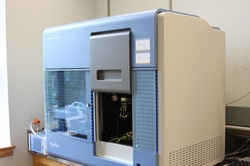 It’s a large but rather inconspicuous box, tinted a cerulean blue and resembling something like a space-shuttle refrigerator. But looks aren’t everything when it comes to the UO biology department’s high-tech $500,000 genome machine, which is capable of decoding DNA at a speed that was once unfathomable.
It’s a large but rather inconspicuous box, tinted a cerulean blue and resembling something like a space-shuttle refrigerator. But looks aren’t everything when it comes to the UO biology department’s high-tech $500,000 genome machine, which is capable of decoding DNA at a speed that was once unfathomable.
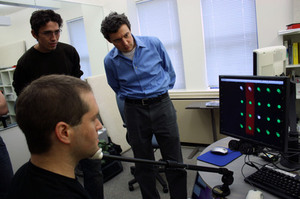 Clay Kent sat down and rested his chin in a little brace that was at the end of a three-foot-long pole. At the other end was a computer monitor displaying a grid of sparkling green dots. Though he looked like he might have been undergoing some kind of Clockwork Orange-style brainwashing, Kent, an undergraduate in digital arts, was actually creating music.
Clay Kent sat down and rested his chin in a little brace that was at the end of a three-foot-long pole. At the other end was a computer monitor displaying a grid of sparkling green dots. Though he looked like he might have been undergoing some kind of Clockwork Orange-style brainwashing, Kent, an undergraduate in digital arts, was actually creating music.
 Say you’re at a cocktail party with a friend, and the room is bustling with the bouncy noise of various conversations. Somehow your brain can siphon all that into a constant din and focus solely on what your friend is saying. “Not even the most sophisticated computer is capable of that,” said UO psychologist Mike Wehr.
Say you’re at a cocktail party with a friend, and the room is bustling with the bouncy noise of various conversations. Somehow your brain can siphon all that into a constant din and focus solely on what your friend is saying. “Not even the most sophisticated computer is capable of that,” said UO psychologist Mike Wehr.
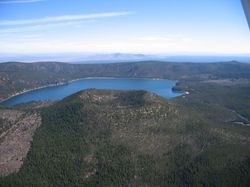 The internal lives of volcanoes are still an unrelenting enigma for scientists. Their interior structures, the ways that magma systems operate, the factors leading to eruptions—all are fertile grounds for research.
The internal lives of volcanoes are still an unrelenting enigma for scientists. Their interior structures, the ways that magma systems operate, the factors leading to eruptions—all are fertile grounds for research.
 Before the financial meltdown and the subprime mortgage fiasco, the field of economics was enjoying an unparalleled time of mass consensus, according to Paul Krugman, the New York Times columnist and Nobel Prize-winning economist. Seduced by their elegant math, most economists believed that market forces had been tamed, and those who had doubts still believed any hiccups could be corrected by the Federal Reserve.
Before the financial meltdown and the subprime mortgage fiasco, the field of economics was enjoying an unparalleled time of mass consensus, according to Paul Krugman, the New York Times columnist and Nobel Prize-winning economist. Seduced by their elegant math, most economists believed that market forces had been tamed, and those who had doubts still believed any hiccups could be corrected by the Federal Reserve.




 Say you’re at a cocktail party with a friend, and the room is bustling with the bouncy noise of various conversations. Somehow your brain can siphon all that into a constant din and focus solely on what your friend is saying. “Not even the most sophisticated computer is capable of that,” said UO psychologist
Say you’re at a cocktail party with a friend, and the room is bustling with the bouncy noise of various conversations. Somehow your brain can siphon all that into a constant din and focus solely on what your friend is saying. “Not even the most sophisticated computer is capable of that,” said UO psychologist 

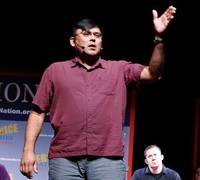
 Learn how experts across disciplines are together advancing green chemistry.
Learn how experts across disciplines are together advancing green chemistry.